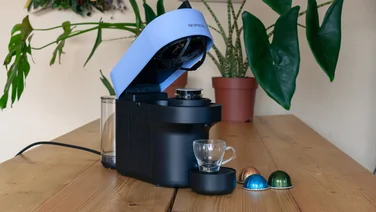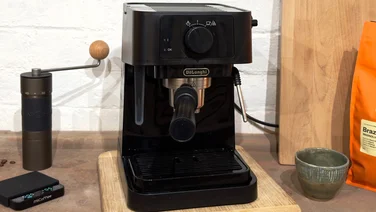To help us provide you with free impartial advice, we may earn a commission if you buy through links on our site. Learn more

Growing up in a rural area, many moons ago, my early memories of coffee are of it being a fairly exotic drink, never mind such fanciful cups of frothiness as cappuccinos or lattés. Nowadays, most people are quite familiar with those drinks, and it even seems that we’ve collectively managed to get our heads around the flat white, the former new kid on the coffee block.
Of course, many of us now have coffee machines in our homes capable of offering a wide variety of drinks at the touch of a button. So, in order to keep on drumming up business, coffee shops have continued to add to their menus, showcasing previously unsung coffee classics and dreaming up new concoctions we might never have imagined.
Whether you want to be fully informed for when you next order, or simply expand your home repertoire, check out our list below – featuring some expert commentary from Tom Saxon, co-founder of Batch Coffee Club . By the end, you’ll be up to speed on the standards, the lesser-known variants and the upstart regional drinks.
Different classic coffee drinks explained
These are some of the most common coffee drinks you’re likely to see on the menu board at your local coffee shop, with a quick explanation of what they are:
Espresso
An espresso is a concentrated shot of coffee, produced by forcing hot water, under high pressure, through fine coffee grounds. It’s characterised by its small size – usually just 30ml – as well as its intense flavour and the dense layer of golden-brown foam, called the crema, that sits atop it. While it is often drunk on its own, a shot of espresso is one of basic building blocks of many of the fancier coffees featured in this article.
Doppio
A double shot of espresso is often called a ‘doppio’ or, more simply, a double espresso. It’s usually 60ml in volume and most coffee shops will use a doppio to make their espresso-based drinks, unless a single or triple shot is specifically requested.
Ristretto
A ristretto is a coffee shot which uses the same quantity of coffee grounds as a regular espresso but less water, resulting in a more concentrated drink with a different flavour profile. Tom’s verdict on ristrettos is that “ristrettos pack a more pronounced punch of flavour, are slightly sweeter and sometimes appear a bit thicker in texture than your standard espresso shot.” The drink is shorter – usually just 20ml – with sweeter notes due to the shorter extraction period, since some of the more bitter flavour compounds, which take more time to extract, don’t make their way into the shot.
Lungo
Lungo – meaning ‘long’ in Italian – is the opposite of a ristretto, using the same quantity of coffee grounds as a regular espresso but, this time, double the amount of water. The greater proportion of water and the longer extraction time mean that a lungo will be less concentrated than a shot of espresso, but may contain more bitter flavour compounds.
Americano
An americano is made by adding hot water to espresso in a ratio of between 1:3 and 1:4. This retains much of the bold flavour, but the dilution means an americano will typically be milder and smoother than an espresso shot.
Long black
An increasingly popular and trendy drink, a long black is similar to an americano, but with one key difference in its preparation. As Tom fills us in, “a long black is hot water with espresso poured over the top. By pouring the espresso over the water, rather than water over espresso, you preserve more of the crema.” However, he doesn’t see what the fuss is all about. “For me, there is no difference. It’s just a naming convention that depends on where you are in the world. If you happen to be in Australia or New Zealand: long black. Americano will pretty much do anywhere else.”
Cappuccino
The first milky coffee on our list, a cappuccino is equal parts espresso, steamed milk, and foamed milk, in that order. Using the frothing wand on an espresso machine, milk is heated and textured by forcing hot steam through it, resulting in a liquid with a smooth, silky texture. The foamed or frothed milk is made in much the same way, but aims to incorporate more air, creating a more aerated liquid with a lighter, bubblier texture.
Latté
Similar to a cappuccino, a latté is made up of espresso and steamed milk with a thin layer of microfoam, combined in a ratio of 1:3. As their name would suggest, and being made with a larger, denser proportion of milk, lattés taste milkier and sweeter than cappuccinos, and tend to have a smoother texture. Lattés are also generally larger than cappuccinos – typically around 240ml, as opposed to 180ml for a cappuccino.
Flat white
One of the most popular coffee drinks of recent years, a flat white is similar to a latté in that it is made up of espresso and steamed milk, but it’s usually a shorter serving size and made with a lower proportion of milk – around 150ml to 180ml, and a 1:2 ratio of espresso to milk. When making a flat white, a barista will aim for a very smooth milk texture with only a very small amount of foam on top.
Mocha
A mocha is a chocolatey coffee, made in much the same way as a latté save for the addition of chocolate powder or syrup, to give it its unique flavour. It’s also often topped with a sprinkling of cocoa powder.
Piccolo
According to Tom, a piccolo “is generally a ristretto shot – smaller, more concentrated espresso – topped with steamed milk, in a smaller glass.” You might think of it as a more intense, miniature latté.
Cortado
What’s a cortado? Tom once again has the answer: “a cortado has equal parts espresso and milk – typically a 1:1 ratio.” According to our expert, it’s slightly different to the piccolo, described above. “Having said that,” Tom adds, “like with a long black and Americano, it depends whether you find yourself in a Spanish or Canadian coffee shop.”
Macchiato
Tom describes a macchiato thusly: “A traditional macchiato is simply an espresso ‘stained’ with a small dollop of steamed milk or milk foam. The name literally means ‘marked’ or ‘spotted’ in Italian, which is a bloody perfect description when you see one served properly.” He makes pains to differentiate them from Starbucks’ macchiatos, which are similar in name alone: “A Starbucks ‘macchiato’, like their ‘Caramel Macchiato’, is basically a modified latté with caramel and vanilla syrup, where the espresso is poured on top of the milk rather than the other way around. It’s about 90% milk and 10% coffee. If you order a macchiato at Starbucks expecting the traditional version, you’ll be in for a very surprising sugar rush.”
Iced latté
A perfect summer drink, an iced latté is made by pulling a double shot of espresso over a cup filled with ice, then topping up the rest of the way with cold milk.
Filter coffee
Filter coffee is prepared differently to the espresso-based drinks listed above. As Tom notes: “Filter coffee refers to any brewing method where water passes through ground coffee and a filter (usually paper), leaving the grounds behind and letting the brewed coffee through. This includes pour-overs, like the V60 or Chemex, but also other brew methods such as a filter coffee machine.” Usually made with lighter roasts and extracted over a longer amount of time, filter coffee can develop bright, fruity, even floral flavours, and is known for its light, clean taste.
Cold brew coffee
Another trendy option, cold brew coffee is quickly becoming a popular fixture at independent coffee shops around the UK. Tom describes the process behind making it: “Cold brew coffee is coffee made by steeping coarsely ground beans in cold water for an extended period – typically 12 to 24 hours. Unlike regular coffee that uses heat to extract flavour, cold brew relies on time. The result is a coffee that’s incredibly smooth, less acidic and often sweeter than hot brewed coffee. It’s not just regular coffee that’s been cooled down – it’s a completely different brewing method that creates a different flavour profile altogether.”
Regional specialty coffee drinks explained
Any independent coffee shop worth their beans will try to woo customers away from the standard fare by having at least one regional specialty drink on their menu, usually from a coffee hotspot like Japan or Australia. For instance, my local coffee shop, 07oz Coffee, makes a mean Kyoto latté, though I won’t pretend that I didn’t have to google it the first time I decided to try one. So, while not exhaustive, our list below should help get you up to speed on the most popular specialty coffee drinks available at the moment.
Pumpkin spice latté
Popularised by Starbucks, and the origin of many memes, this seasonal drink can be found in most coffee shops as an autumnal option every year. Sticking to the classic latté formula of espresso and steamed milk, the pumpkin spice latté is then distinguished by the addition of spices like nutmeg, cinnamon, allspice and some sort of sweetener, with some recipes also calling for pumpkin purée to help bring out those flavours and give the drink a smoother texture. Pumpkin spice lattés tend to be milky and sweet, with a warm, spiced flavour. Have a look at my complete guide if you want to learn how to make a pumpkin spice latté at home.
Dirty chai latté
‘Chai’ is the Indian word for tea, and it typically describes a drink of heated milk and black tea, infused with spices like cinnamon, ginger and cardamom. A chai latté has the same base of spiced black tea, but then topped with steamed milk, as you would a regular latté. Finally, a ‘dirty chai latté’ is prepared the same as chai latté, but with the addition of a single or double shot of espresso. A good dirty chai latté should have a warm, spiced taste with a strong coffee flavour.
Kyoto latté
First popularised in Japan, a Kyoto latté is similar to a regular latté, except that it includes a touch of condensed milk. This makes for a drink that is very rich and sweet, almost more akin to a dessert than a regular coffee.
Vietnamese coffee
An increasingly common sight in artisanal coffee houses and boba tea shops, a Vietnamese coffee consists of a number of tablespoons of condensed milk which is topped up with black coffee. However, unlike most of the coffee you’ll get in the UK, Vietnamese coffee is not made with arabica beans – known for their range of nutty, fruity and chocolatey notes – but with robusta beans, which typically have a more earthy, bitter flavour. Popular variants of this coffee include an iced version and a coconut version, where the condensed milk is blended with coconut milk, powder or cream, to create a unique flavour profile.
Dalgona coffee
A trendy drink invented in Macau during the COVID-19 pandemic, and subsequently popularised in Korea, a Dalgona coffee is made by whipping together equal parts instant coffee powder, sugar and hot water until they develop a creamy texture, before pouring this mixture over hot or cold milk. A dalgona coffee can be topped with crumbled biscuits, honey or chunks of sugar sweets.
Freddo cappuccino
Popular in and around Greece, a Freddo cappuccino is an iced version of the classic drink made by shaking together espresso and ice, then poured over more ice and topped with dense, cold-frothed milk.
Café del Tiempo
Finally, I asked Tom whether he had a favourite regional specialty, and he chose the Spanish serving style ‘Café del Tiempo’. He says “it’s essentially an espresso served with a separate glass of ice and usually a slice of lemon on the side. You’ll find locals sipping these on café terraces all across Spain during summer, especially on the Mediterranean coast.”






